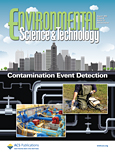Environmental Science and Technology 46(15)
Overview of new articles on POPs in a new issue of the Environmental Science and Technology journal.

Hua Wei, Azivy Che Aziz-Schwanbeck, Yonghong Zou, Margaret B. Corcoran, Armen Poghosyan, An Li, Karl J. Rockne, Erik R. Christensen, and Neil C. Sturchio
pp 8017–8024
- South-central Arkansas (AR) is home to major manufacturing facilities for brominated flame retardant chemicals (BFRs) in the U.S. Unintended release during production may have caused accumulation of the BFRs in the local environment. In this work, sediment cores were collected from six water bodies in AR, including three located close to the BFR manufacturing facilities in El Dorado and Magnolia, to investigate past and recent deposition histories.
Fate of Chiral and Achiral Organochlorine Pesticides in the North Atlantic Bloom Experiment
Lin Zhang, Terry Bidleman, Mary Jane Perry, and Rainer Lohmann
pp 8106–8114
- Organochlorine pesticides (OCPs) were measured in the surface seawater and lower atmosphere during the North Atlantic Bloom Experiment in the spring 2008 from samples collected on the R/V Knorr. The gaseous concentration profiles resulted from both long-range transport (LRT) from the Arctic by polar easterlies and local biogeochemical processes.
Guofeng Shen, Shu Tao, Siye Wei, Yanyan Zhang, Rong Wang, Bin Wang, Wei Li, Huizhong Shen, Ye Huang, Yuanchen Chen, Han Chen, Yifeng Yang, Wei Wang, Xilong Wang, Wenxin Liu, and Staci L. M. Simonich
pp 8123–8130
- Residential wood combustion is one of the important sources of air pollution in developing countries. Among the pollutants emitted, parent polycyclic aromatic hydrocarbons (pPAHs) and their derivatives, including nitrated and oxygenated PAHs (nPAHs and oPAHs), are of concern because of their mutagenic and carcinogenic effects. In order to evaluate their impacts on regional air quality and human health, emission inventories, based on realistic emission factors (EFs), are needed. In this study, the EFs of 28 pPAHs (EFPAH28), 9 nPAHs (EFPAHn9), and 4 oPAHs (EFPAHo4) were measured for residential combustion of 27 wood fuels in rural China.
Jan Dolfing, Igor Novak, Alain Archelas, and Hervé Macarie
pp 8131–8139
- Chlordecone (C10Cl10O; CAS number 143-50-0) has been used extensively as an organochlorine insecticide but is nowadays banned under The Stockholm Convention on Persistent Organic Pollutants (POPs). A search for chlordecone-respiring organisms and choosing between reductive versus oxidative remediation tools and strategies to clean up chlordecone-polluted environments would benefit from the availability of Gibbs free energy data of chlordecone and its potential dechlorination products.
Xiaomin Sun, Chenxi Zhang, Yuyang Zhao, Jing Bai, Qingzhu Zhang, and Wenxing Wang
pp 8148–8155
- Reactions with the OH radical are expected to be the dominant removal processes for gas-phase polychlorinated dibenzo-p-dioxins and dibenzofuran (PCDD/Fs). The OH-initiated atmospheric chemical reaction mechanism and kinetics of 2,3,7,8-tetrachlorinated dibenzofuran (TCDF) are researched using the density functional theory and canonical variational transition state theory.
Paul R. Erickson, Matthew Grandbois, William A. Arnold, and Kristopher McNeill
pp 8174–8180
- The photochemical conversion of selected hydroxylated polybrominated diphenyl ethers (OH-PBDEs) to dioxins and other products was investigated. OH-PBDEs, which are both transformation products of polybrominated diphenyl ethers and naturally occurring compounds, undergo direct photolysis to yield a number of products that may have a higher toxicity than their parent. The compounds investigated were 6-OH-PBDE 99, 6′-OH-PBDE 100, and 6′-OH-PBDE 118.
8.8.2012




